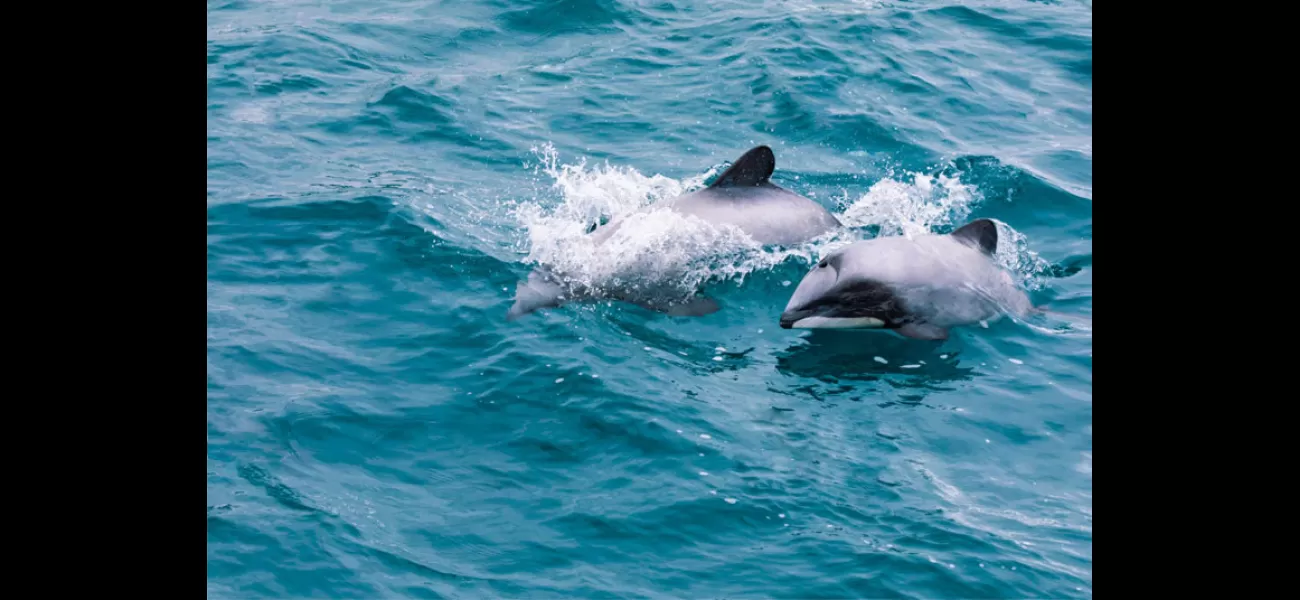AI isn't going to destroy the world, it's actually doing the opposite.
We are not the ones in danger of disappearing...
March 16th 2024.

Off the coast of New Zealand's west coast, in the clear blue waters that match the brilliance of the sky above, a pod of rare dolphins can be seen gliding gracefully beneath the surface. Every now and then, they playfully break through the barrier between ocean and air, creating a splash of white foam before diving back down. To the observer, it's a joyous sight, but behind their playful antics lies a heartbreaking story of decline.
These are the Māui dolphins, a sub-species of the Hector's dolphin that can only be found in this part of the world. They are easily recognizable by their white, grey, and black markings and their distinctive rounded dorsal fin, often compared to the ears of Mickey Mouse. However, despite their unique appearance, they are becoming increasingly difficult to spot. Pollution, climate change, and fishing activities in the region have pushed them to the brink of extinction. They are not the intended target of fishing nets, but they often become caught in them. Currently, there are only 54 Māui dolphins left in existence.
It may seem like a strangely specific number for a group of animals living in such a vast expanse of ocean, especially when they all look very similar. But thanks to the latest technology, we are able to keep track of their dwindling population. Yes, the same artificial intelligence that some fear will take over our jobs and bring about the end of humanity. But for now, it is actually doing some good.
In the past, the Māui dolphins were only monitored every five years by the Department of Conservation and University of Auckland scientists. They would count the dolphins during a three-week period in the summer when they were known to swim close to the shore. However, this method did not provide a clear enough picture of how the dolphins were faring or what could be done to help them. To address this issue, the conservation charity MAUI63, named after the 63 dolphins that were left when the organization was formed in 2018, has turned to the latest technology.
In collaboration with the Ministry of Primary Industries and the fishing industry, they have developed an AI-powered tracking drone that can autonomously find, follow, and identify the remaining Māui dolphins using image recognition technology. Tane van der Boon, co-founder of MAUI63, explains that unlike boat-based monitoring, the drones are not limited by rough waters and can be deployed more regularly. Equipped with an 8K ultra-high-definition camera and an HD gimbal camera with an object detection model, the drones are able to spot dolphins by their unique dorsal fin shapes and markings, such as scars and scratches. This open-source algorithm, originally developed for facial recognition, is hosted on Microsoft Azure.
Knowing how many dolphins are left is only part of the solution. The data collected by the drones is also used to inform the fishing industry of the dolphins' current locations so they can avoid those areas. Another major threat to the dolphins is toxoplasmosis, a disease caused by a parasite that enters the marine food chain through runoff from land. Tane explains that the insights provided by the drones about the dolphins' preferred habitats can help narrow down studies on how the disease is entering these areas and how to limit its spread.
Closer to home, similar animal recognition technology is being used to monitor and count puffins on the Isle of May. These beloved "parrots of the sea" are at risk as their habitats and food supplies shrink. In the past, counting these birds was a hands-on job, with rangers physically counting and even digging around in burrows to count eggs, often getting nipped in the process. But a new project, supported by SSE Renewables, Microsoft, Avanade, and NatureScot, is using cameras and AI to monitor and count puffins without disturbing them.
While the use of facial recognition technology raises ethical concerns about privacy and anonymity for humans, there is little reason to complain when it comes to identifying these adorable birds. But AI recognition is not just about looks. National Rail, in partnership with the Zoological Society of London and Google Cloud, has developed remote sensing technology that uses cameras and audio to detect the presence of wildlife, specifically the hazel dormouse.
This tiny, elusive creature was once widespread but is now extinct in 20 counties in the UK and has seen a 70% decline in numbers just this century. Neil Strong, Network Rail's biodiversity strategy manager, explains that remote sensing technology, such as camera traps, allows wildlife to come to us instead of having to physically go out and find them. He adds that the AI has made tracking more efficient across different species, eliminating the need to visit every nest box or sift through hours of footage. With nearly 50,000 hectares of land to manage, Network Rail is committed to making their green spaces as wildlife-friendly as possible while also managing them appropriately as a railway.
In conclusion, while AI may have its drawbacks and ethical concerns, there is no denying its potential for good in conservation efforts. From tracking and protecting endangered species to monitoring and preserving habitats, the latest technology is proving to be a valuable tool in the fight to protect our planet's precious wildlife.
Off the west coast of New Zealand, the azure waters are a stunning sight to behold. The blue skies above seem to match the brilliance of the ocean, creating a picturesque scene. In this idyllic setting, a pod of rare dolphins can be seen gliding gracefully just below the surface.
At times, these majestic creatures break through the boundary between water and air, leaping into the sky before disappearing back into the depths. To a casual observer, it may seem like they are simply having fun and enjoying life. However, the truth is far more sobering.
These dolphins are known as Māui dolphins, a sub-species of the Hector's dolphin that can only be found in this specific region. They are easily recognizable by their distinctive white, grey, and black markings and rounded dorsal fin, often compared to Mickey Mouse ears. But despite their unique appearance, their numbers are dwindling at an alarming rate.
Pollution, climate change, and fishing in the area have pushed these dolphins to the brink of extinction. They are not the target of fishermen, but often end up caught in nets. Sadly, there are now only 54 Māui dolphins left in the world.
It may seem like a strangely specific number for a group of animals that live in such a vast and ever-changing environment. However, we have artificial intelligence to thank for this accurate count. Yes, the same AI that some fear will one day take over humanity is currently being used for good.
In the past, the Māui dolphins were only monitored once every five years by the Department of Conservation and University of Auckland scientists. This was done during a short three-week window in the summer when the dolphins would swim close to shore. However, this method did not provide a complete picture of their population or the threats they faced.
To address this issue, the conservation charity MAUI63, named after the 63 dolphins that existed when it was founded in 2018, has turned to cutting-edge technology. In collaboration with the Ministry of Primary Industries and the fishing industry, they have developed an AI-powered tracking drone that can autonomously find, follow, and identify the remaining Māui dolphins using advanced image recognition technology.
Tane van der Boon, co-founder of MAUI63, and his team with their drone
Unlike traditional boat-based monitoring, the drones are not limited by rough coastal waters and can be deployed more frequently. This has allowed the team to monitor the dolphins on a monthly basis, all year round. However, simply knowing how many dolphins are left is not enough to protect them.
The data collected by the drones is used to provide real-time locations to the fishing industry, allowing them to avoid these areas and reduce accidental dolphin deaths. The drones have also helped identify the threat of toxoplasmosis, a disease-causing parasite that enters the marine food chain through land runoff and has been causing stillbirths and deaths among Māui dolphins.
Similar AI technology is being used to monitor and protect other endangered species around the world. For example, on the Isle of May, cameras and AI are being used to count puffins without disturbing them. This method is much less intrusive than the traditional hands-on approach of digging around in burrows and counting eggs.
Closer to home, Network Rail, in partnership with the Zoological Society of London and Google Cloud, has developed remote sensing technology that uses both cameras and audio to detect the presence of wildlife, particularly the endangered hazel dormouse. This tiny creature, once widespread, is now extinct in 20 counties and has seen a 70% decline in numbers in just this century.
Network Rail's biodiversity strategy manager, Neil Strong, explains that this technology allows wildlife to come to them instead of having to physically search for different species. This has made tracking and monitoring more efficient and has eliminated the need for manual nest box checks and hours of footage sifting.
With close to 50,000 hectares of land to manage, Network Rail understands the importance of creating a wildlife-friendly environment while also keeping in mind their primary purpose as a railway. Their efforts to manage the land in a way that benefits both people and animals are a testament to their commitment to conservation.
In the end, these examples show that AI, when used for good, can have a positive impact on the world around us. From accurately counting endangered species to identifying and addressing threats, this technology is proving to be a valuable tool in the fight against extinction. As we continue to advance and improve our methods of conservation, we must also ensure that we use them responsibly and ethically.
These are the Māui dolphins, a sub-species of the Hector's dolphin that can only be found in this part of the world. They are easily recognizable by their white, grey, and black markings and their distinctive rounded dorsal fin, often compared to the ears of Mickey Mouse. However, despite their unique appearance, they are becoming increasingly difficult to spot. Pollution, climate change, and fishing activities in the region have pushed them to the brink of extinction. They are not the intended target of fishing nets, but they often become caught in them. Currently, there are only 54 Māui dolphins left in existence.
It may seem like a strangely specific number for a group of animals living in such a vast expanse of ocean, especially when they all look very similar. But thanks to the latest technology, we are able to keep track of their dwindling population. Yes, the same artificial intelligence that some fear will take over our jobs and bring about the end of humanity. But for now, it is actually doing some good.
In the past, the Māui dolphins were only monitored every five years by the Department of Conservation and University of Auckland scientists. They would count the dolphins during a three-week period in the summer when they were known to swim close to the shore. However, this method did not provide a clear enough picture of how the dolphins were faring or what could be done to help them. To address this issue, the conservation charity MAUI63, named after the 63 dolphins that were left when the organization was formed in 2018, has turned to the latest technology.
In collaboration with the Ministry of Primary Industries and the fishing industry, they have developed an AI-powered tracking drone that can autonomously find, follow, and identify the remaining Māui dolphins using image recognition technology. Tane van der Boon, co-founder of MAUI63, explains that unlike boat-based monitoring, the drones are not limited by rough waters and can be deployed more regularly. Equipped with an 8K ultra-high-definition camera and an HD gimbal camera with an object detection model, the drones are able to spot dolphins by their unique dorsal fin shapes and markings, such as scars and scratches. This open-source algorithm, originally developed for facial recognition, is hosted on Microsoft Azure.
Knowing how many dolphins are left is only part of the solution. The data collected by the drones is also used to inform the fishing industry of the dolphins' current locations so they can avoid those areas. Another major threat to the dolphins is toxoplasmosis, a disease caused by a parasite that enters the marine food chain through runoff from land. Tane explains that the insights provided by the drones about the dolphins' preferred habitats can help narrow down studies on how the disease is entering these areas and how to limit its spread.
Closer to home, similar animal recognition technology is being used to monitor and count puffins on the Isle of May. These beloved "parrots of the sea" are at risk as their habitats and food supplies shrink. In the past, counting these birds was a hands-on job, with rangers physically counting and even digging around in burrows to count eggs, often getting nipped in the process. But a new project, supported by SSE Renewables, Microsoft, Avanade, and NatureScot, is using cameras and AI to monitor and count puffins without disturbing them.
While the use of facial recognition technology raises ethical concerns about privacy and anonymity for humans, there is little reason to complain when it comes to identifying these adorable birds. But AI recognition is not just about looks. National Rail, in partnership with the Zoological Society of London and Google Cloud, has developed remote sensing technology that uses cameras and audio to detect the presence of wildlife, specifically the hazel dormouse.
This tiny, elusive creature was once widespread but is now extinct in 20 counties in the UK and has seen a 70% decline in numbers just this century. Neil Strong, Network Rail's biodiversity strategy manager, explains that remote sensing technology, such as camera traps, allows wildlife to come to us instead of having to physically go out and find them. He adds that the AI has made tracking more efficient across different species, eliminating the need to visit every nest box or sift through hours of footage. With nearly 50,000 hectares of land to manage, Network Rail is committed to making their green spaces as wildlife-friendly as possible while also managing them appropriately as a railway.
In conclusion, while AI may have its drawbacks and ethical concerns, there is no denying its potential for good in conservation efforts. From tracking and protecting endangered species to monitoring and preserving habitats, the latest technology is proving to be a valuable tool in the fight to protect our planet's precious wildlife.
Off the west coast of New Zealand, the azure waters are a stunning sight to behold. The blue skies above seem to match the brilliance of the ocean, creating a picturesque scene. In this idyllic setting, a pod of rare dolphins can be seen gliding gracefully just below the surface.
At times, these majestic creatures break through the boundary between water and air, leaping into the sky before disappearing back into the depths. To a casual observer, it may seem like they are simply having fun and enjoying life. However, the truth is far more sobering.
These dolphins are known as Māui dolphins, a sub-species of the Hector's dolphin that can only be found in this specific region. They are easily recognizable by their distinctive white, grey, and black markings and rounded dorsal fin, often compared to Mickey Mouse ears. But despite their unique appearance, their numbers are dwindling at an alarming rate.
Pollution, climate change, and fishing in the area have pushed these dolphins to the brink of extinction. They are not the target of fishermen, but often end up caught in nets. Sadly, there are now only 54 Māui dolphins left in the world.
It may seem like a strangely specific number for a group of animals that live in such a vast and ever-changing environment. However, we have artificial intelligence to thank for this accurate count. Yes, the same AI that some fear will one day take over humanity is currently being used for good.
In the past, the Māui dolphins were only monitored once every five years by the Department of Conservation and University of Auckland scientists. This was done during a short three-week window in the summer when the dolphins would swim close to shore. However, this method did not provide a complete picture of their population or the threats they faced.
To address this issue, the conservation charity MAUI63, named after the 63 dolphins that existed when it was founded in 2018, has turned to cutting-edge technology. In collaboration with the Ministry of Primary Industries and the fishing industry, they have developed an AI-powered tracking drone that can autonomously find, follow, and identify the remaining Māui dolphins using advanced image recognition technology.
Tane van der Boon, co-founder of MAUI63, and his team with their drone
Unlike traditional boat-based monitoring, the drones are not limited by rough coastal waters and can be deployed more frequently. This has allowed the team to monitor the dolphins on a monthly basis, all year round. However, simply knowing how many dolphins are left is not enough to protect them.
The data collected by the drones is used to provide real-time locations to the fishing industry, allowing them to avoid these areas and reduce accidental dolphin deaths. The drones have also helped identify the threat of toxoplasmosis, a disease-causing parasite that enters the marine food chain through land runoff and has been causing stillbirths and deaths among Māui dolphins.
Similar AI technology is being used to monitor and protect other endangered species around the world. For example, on the Isle of May, cameras and AI are being used to count puffins without disturbing them. This method is much less intrusive than the traditional hands-on approach of digging around in burrows and counting eggs.
Closer to home, Network Rail, in partnership with the Zoological Society of London and Google Cloud, has developed remote sensing technology that uses both cameras and audio to detect the presence of wildlife, particularly the endangered hazel dormouse. This tiny creature, once widespread, is now extinct in 20 counties and has seen a 70% decline in numbers in just this century.
Network Rail's biodiversity strategy manager, Neil Strong, explains that this technology allows wildlife to come to them instead of having to physically search for different species. This has made tracking and monitoring more efficient and has eliminated the need for manual nest box checks and hours of footage sifting.
With close to 50,000 hectares of land to manage, Network Rail understands the importance of creating a wildlife-friendly environment while also keeping in mind their primary purpose as a railway. Their efforts to manage the land in a way that benefits both people and animals are a testament to their commitment to conservation.
In the end, these examples show that AI, when used for good, can have a positive impact on the world around us. From accurately counting endangered species to identifying and addressing threats, this technology is proving to be a valuable tool in the fight against extinction. As we continue to advance and improve our methods of conservation, we must also ensure that we use them responsibly and ethically.
[This article has been trending online recently and has been generated with AI. Your feed is customized.]
[Generative AI is experimental.]
0
0
Submit Comment





